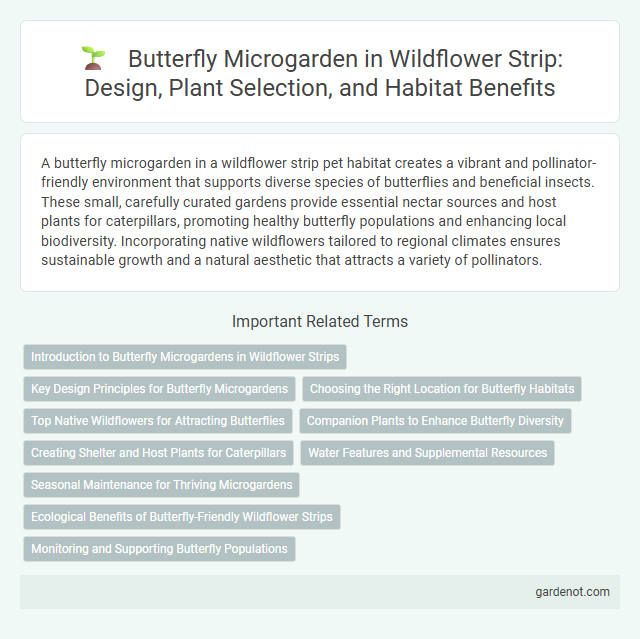A butterfly microgarden in a wildflower strip pet habitat creates a vibrant and pollinator-friendly environment that supports diverse species of butterflies and beneficial insects. These small, carefully curated gardens provide essential nectar sources and host plants for caterpillars, promoting healthy butterfly populations and enhancing local biodiversity. Incorporating native wildflowers tailored to regional climates ensures sustainable growth and a natural aesthetic that attracts a variety of pollinators.
Introduction to Butterfly Microgardens in Wildflower Strips
Butterfly microgardens within wildflower strips create specialized habitats that support diverse butterfly species through the cultivation of native nectar-rich flowers and host plants. These microgardens enhance pollinator activity and biodiversity by providing essential resources like milkweed for monarchs and asters for swallowtails. Strategic planting designs in butterfly microgardens boost ecological resilience and contribute significantly to urban and rural conservation efforts.
Key Design Principles for Butterfly Microgardens
Butterfly microgardens maximize biodiversity by incorporating native wildflower strips that provide essential nectar sources and larval host plants. Selecting a variety of flowering species ensures continuous bloom cycles, supporting multiple butterfly species throughout their life stages. Strategic placement in sunny, sheltered locations enhances pollinator activity and microhabitat stability.
Choosing the Right Location for Butterfly Habitats
Selecting an optimal location for a butterfly microgarden within a wildflower strip involves ensuring ample sunlight, as butterflies thrive in warm, sunny spots. The area should be sheltered from strong winds to provide a safe environment for feeding and breeding. Proximity to nectar-rich flowers and host plants is essential to support the entire butterfly lifecycle and promote biodiversity.
Top Native Wildflowers for Attracting Butterflies
Top native wildflowers for attracting butterflies in a butterfly microgarden include milkweed (Asclepias spp.), coneflowers (Echinacea spp.), and butterfly weed (Asclepias tuberosa). These species provide essential nectar sources and host plants for caterpillars, supporting the complete life cycle of butterflies. Incorporating native asters (Symphyotrichum spp.) and blazing stars (Liatris spp.) enhances pollinator diversity and garden resilience.
Companion Plants to Enhance Butterfly Diversity
Companion plants such as milkweed, coneflowers, and goldenrod create a diverse habitat that supports butterfly microgardens by providing essential nectar and larval host resources. Incorporating a variety of native wildflower species in a wildflower strip encourages multiple butterfly species to thrive, boosting local biodiversity and ecosystem resilience. Strategic planting of companion plants enhances butterfly diversity by attracting pollinators and nurturing their life cycles effectively.
Creating Shelter and Host Plants for Caterpillars
Planting a butterfly microgarden with a diverse selection of native wildflower strips provides essential shelter and host plants critical for caterpillar development. Species such as milkweed, dill, and fennel offer both food and protective habitat, supporting various butterfly larvae through their growth stages. Incorporating dense foliage and layered plant heights enhances microclimate stability, improving survival rates for emerging butterflies.
Water Features and Supplemental Resources
Water features in a butterfly microgarden create essential habitats that attract diverse butterfly species by providing hydration and breeding grounds. Supplemental resources such as nectar-rich plants, mud puddles, and shallow dishes with damp sand enhance butterfly survival and encourage prolonged visits. Incorporating these elements supports local butterfly populations and promotes ecological balance within the wildflower strip.
Seasonal Maintenance for Thriving Microgardens
Seasonal maintenance for a butterfly microgarden in a wildflower strip involves regular monitoring of native plants such as milkweed, coneflowers, and asters to ensure optimal growth and nectar availability. Pruning spent blooms and managing invasive species supports butterfly lifecycle stages from caterpillar to adult, enhancing pollination and biodiversity. Adapting watering schedules and soil health practices according to seasonal changes maximizes plant resilience and butterfly habitat sustainability.
Ecological Benefits of Butterfly-Friendly Wildflower Strips
Wildflower strips designed as butterfly microgardens provide essential nectar sources that support pollinator health and biodiversity in local ecosystems. These habitats promote natural pest control by attracting beneficial insects, reducing reliance on chemical pesticides. Establishing butterfly-friendly wildflower strips enhances soil quality and encourages genetic diversity among native plant species, contributing to resilient and sustainable landscapes.
Monitoring and Supporting Butterfly Populations
Butterfly microgardens with wildflower strips provide essential habitats that boost local butterfly populations by supplying nectar-rich flowers and host plants for caterpillars. Monitoring these areas through regular surveys of butterfly species diversity and abundance helps track population health and identify environmental stressors. Supporting butterfly populations involves planting native wildflowers, minimizing pesticide use, and creating continuous floral corridors to enhance feeding and breeding opportunities.
Butterfly microgarden Infographic

 gardenot.com
gardenot.com